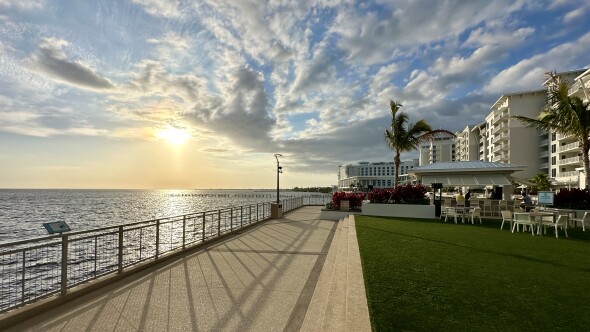UNIVERSITY PLACE, Wash. -- While the lead-up to the U.S. Open at Chambers Bay has had its fair share of critical comments, it seemed that the Monday of U.S. Open week was a day of celebration.
There is, in fact, a lot to celebrate about Chambers Bay. A mining site for 100 years, it's now become a public park, and the $20-million golf course is expected to bring an estimated $100 million-plus in economic activity to the area.
On Monday, the USGA held an Architect's Forum, hosted by Executive Director Mike Davis and course architect Robert Trent Jones Jr. Here are some highlights from the discussion:
Robert Trent Jones Jr. on county executive John Ladenburg and his vision for the property:
"What John Ladenburg did was extraordinarily courageous. He was elected the county executive. Obviously he had to watch out for the firemen, the police, the public safety, as well as the well being of the citizens. And he came upon this piece of ground that was a mine for 100 years, the stone that came out to build the roads of Washington state. And he said it's a big mess. It was dusty and the people of University Place weren't happy.
"He said, 'I could sell this to a housing developer or I can create a regional park for the public.' And you have to remember, it wasn't just about the golf course. He wanted a park for the people, a walking park for the people who had their dogs and strollers, a children's park which we have at the north end, as well as a way across the railroad tracks to the beach, and where we are right in this area right now, which is a park for concerts and so on, so it was a regional park."
Video: Matt Ginella on the history of Chambers Bay
Jones on his first impressions of the unique site:
"We had the natural wonder of sand. That's what I saw: sand, sand, sand. The miners had left us, the tailings are set. As anybody knows, we architects and golfers kill for sand. It's the links on the sand. Anytime we can work the sand, you can craft the many, many fine points of the game, the ground game as well as the aerial game. And it will drain and grow great turf upon which to play. And that's what we saw."
Jones on the decision to go with fescue grass wall-to-wall at Chambers Bay:
"Yes, I did want a links. We had tried once before with Tom Watson and Sandy Tatum, great USGA president and friend of ours, at Spanish Bay, and we put fescue grasses there, but that's more of a Mediterranean climate and it didn't last. And it's now a soft links, we call it, meaning its poa annua and rye grass.
"[At Chambers Bay], Bruce Charles, my partner, and I looked at Google Earth and said where are we? We're in a maritime climate. A maritime climate is as Irish as they come, which allowed the indigenous grass to be fescue and to grow naturally. This is self-seeding rough. We have no irrigation out there. The rough took four or five years to establish and those sand dunes, which were man-made, but it seeds itself. So nature was our friend and we knew we could do it."
Mike Davis on first considering Chambers Bay for a U.S. Open:
"[I was told] it's got almost 1,000 acres. Really? Now all of a sudden I'm thinking, well, operationally, we don't need anywhere near 1,000 acres, but most of the time we're trying to stage one of these events, many golf courses simply do not have enough land to stage it. And then [we were told] it's going to be county owned, so it's going to be a public-access golf course, which is a great thing for the daily golfer to be able to play a U.S. Open golf course.
"We've been conducting U.S. Open for over 120 years and have never been to this part of the country. And then I think the thing that really got me was when he said it's all sand. And as Bob rightly said, and I believe it, I've heard Bob say it, every golf course -- any golf course would be better if it's built on sand because it drains better. The ball bounces. It's that aspect of the game that's just so much fun."
Davis on the Jones family's legacy with the U.S. Open and American course design:
"I think one of the best things about being in the position I'm in is getting to know people like Bob and some of the great architects of all time. ... You think about all the influence he's had on architecture, on U.S. Opens, on national championships and then what Bob has done, and Bob's brother, Rees Jones, and the Jones family in terms of architecture and their contributions to the game and our national championships is just unbelievable."
Jones on walking nine holes of Chambers Bay with 2013 U.S. Open champion Justin Rose:
"Justin is very methodical. He's really studying the course. He played alone. So he's studying the course. And I think the second thing I want to say about this, being up close to a player of that skill level, the ball-striking is just phenomenal. [He says] 'I'm going to hit it at the crease on the right side of where the ricochet mound is on the right side of the tree,' and he hits it there. 'Maybe I'll hit it 10 yards left,' and he hits it there. He's playing phenomenally. So this is very important. What he said was, I have to learn to move the ball into the bounces, so it softens the shots. He's already thinking how to adapt his game to the aerial game, to the links game, at his skill level."
Davis on varying opinions of Chambers Bay leading up to the U.S. Open:
"There's certain horses for different courses, and I think here this week it's a different style. But at the end of it, it's going to be a very stern, comprehensive test. It's going to show shot-making skills and abilities. It's going to require the players to really think their way around. And it's going to present a different challenge every day, not only on how we set the golf course up but the weather we'll get. We've got a wonderful forecast for the week. But we're looking at probably the first day, day and a half, Thursday and part of the day Friday with maybe a light wind out of the southwest. Then it's going to shift out of the north and just by that thing, it's going to change the nature of how the holes play, which will be fantastic.
"It's fun to showcase this architecture and it's been just delightful working with Bob and Bruce through this process and it really should be just a marvelous, but a very unique and ... one-of-a-kind test.















